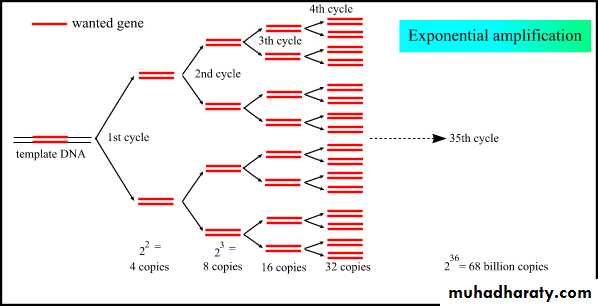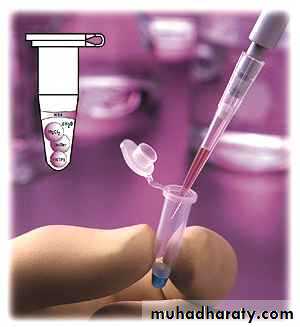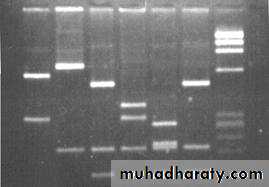Introduction to PCR Polymerase Chain Reaction
Why Polymerase Chain Reaction (PCR)?
Polymerase: DNA polymeraseDNA polymerase is the only enzyme used in PCR and actions through duplication of DNA
Chain Reaction: The product of a reaction is used to amplify the same reaction
Results in rapid increase in the productWhat is PCR
PCR is a laboratory version of DNA replication in cellsDNA replication inside living cell
PCR in test tubePCR is a laboratory technique used to: amplify specific region of DNA (gene) , in order to make a huge number of copies of that gene to be adequately tested.
So PCR:1. first detect the gene of interest in the genomic DNA2. then amplifies it to make billions copies of that gene in just few hours
Genomic DNA
Gene of interestThe Problem...
TWO BIG ISSUES:There are a LOT of other sequences in a genome that we’re not interested in detecting. (SPECIFICITY)
The amount of DNA in samples we’re interested in is VERY small. (AMPLIFICATION)
To “see” a single “gene”, the DNA in a sample of
100 cells would have to be multiplied 180 milliontimes!!!!!
(How do we identify and detect a specific sequence in a genome?)
The Problem...TWO BIG ISSUES:
There are a LOT of other sequences in a genome that we’re not interested in detecting.
The amount of DNA in samples we’re interested in is VERY small. (AMPLIFICATION)
PCR can solve BOTH of these issues!!!PCR can make billions of copies of a specific
gene of interest in just few hours!!!!!!(Amazing)
(How do we identify and detect a specific sequence in a genome?)
SpecificityAmplification
Pattern of Amplification of gene product by PCR
PCR amplifies gene of interest through what is called exponential amplification
2
4
8
16
32
so on
Exponential multiplication
Exponential multiplicationExponential multiplication
Exponential multiplicationExponential multiplication
Exponential multiplication
Exponential multiplication
What you need to perform a PCR reaction?Preparation of samples
PCR machineVisualization of PCR product
1. Preparation of PCR samples
DNA template
Needs a pre-existing DNA to duplicate
Cannot assemble a new strand from components1. Preparation of PCR samples
DNA Primers (for the detection of gene of interest)Short nucleotide sequence (18-30 nucleotides)
Forward primer
Anneals to DNA anti-sense strand
Reverse primer
Anneals to DNA sense strand1. Preparation of PCR samples
PCR master mixTaq polymerase
Enzyme that extends growing DNA strand complementary to DNA template
MgCl2
Provides ions needed for enzyme reactiondNTP’s
Nucleotides (Adenine, Cytosine, Guanine, Thymine) building blocks for new DNA strandsBuffer
Maintains optimal pH for enzymeTypical PCR sample
In a thin wall Eppendorf tube assemble the following• PCR components
• Amount
• Template DNA (5-200 ng)
• 1 mM dNTPs (200 uM final)
• 10 X PCR buffer
• 25 mM MgCl2 (1.5 mM final)
• 20 uM forward primer (20 pmoles final)
• 20 uM reverse primer (20 pmoles final)
• 5 units/uL Taq DNA polymerase (1.5 units)
• Water
• Final Volume
• variable
• 10 uL
• 5 uL
• 3 uL
• 1 uL
• 1 uL
• 0.3 uL
• Variable
• 50 uL
2. PCR machine
Now, the DNA template, DNA polymerase, buffer, dNTPs and primers are placed in a thin-walled tube and then these tubes are placed in the PCR thermal cycler
PCR Thermocycler
What is going on inside PCR machine? Thermal Cycling
A PCR machine controls temperatureTypical PCR go through three steps
Denaturation
Annealing
Extension
Denaturation
Heating up to 95 °C separates the double stranded DNADenaturation
Slow cooling anneals the two strands
Renaturation
Cool
Heating t (95 °C)Annealing
Two primers are supplied in molar excess
They bind to the complementary region
Optimal temperature varies based on primer length etc.
Typical temperature from 40 to 60 C
Extension• DNA polymerase duplicats DNA
• Optimal temperature 72C
PCR Amplification
Exponential Amplification of template DNA
Example of thermocycler parameters used to amplify a particular gene of interest
• Cycle step• Temperature
• Time
• Cycles
• Initial denaturation
• 95°C
• 30 seconds
• 1
• Denaturation
• Annealing
• Extension
• 95°C
• *
• 72°C
• 5-10 seconds
• 10-30 seconds
• 1 minute
• 30 cycles
• Final extension
• 72°C
• 4°C
• 5 minutes
• hold
• 1
3. Visualization of PCR product
Need visualization system to confirm the presence of the PCR product
(Agarose Gel Electrophoresis) Small fraction of PCR product is loaded on agarose gel together with DNA loading dye
Agarose gel is then put on UV transiluminator to visualise PCR product
3. Visualization of PCR productPositive PCR product should look like this
Conventional Vs Real-time PCR
Conventional PCRThe amplified product is detected by an end-point analysis i.e. by running DNA on an agarose gel after the reaction has finished.
Real-time PCR
Real-time PCR allows the accumulation of amplified product to be detected and measured as the reaction progresses, that is, in “real time”.Conventional Vs Real -Time PCR















